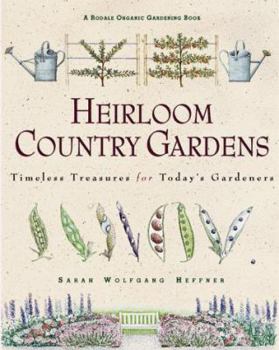Heirloom Country Gardens: Timeless Treasures for Today's Gardeners
Select Format
Select Condition 
Book Overview
Love history as much as you love plants? Interested in resurrecting some nearly forgotten and delicious garden vegetables? Heirloom Country Gardens offers a wealth of suggestions in a lovely format... This description may be from another edition of this product.
Format:Hardcover
Language:English
ISBN:087596818X
ISBN13:9780875968186
Release Date:January 2000
Publisher:Rodale Books
Length:256 Pages
Weight:1.75 lbs.
Dimensions:0.8" x 7.8" x 9.4"
Related Subjects
By Region By Technique Crafts & Hobbies Garden Design Gardening Gardening & LandscapingCustomer Reviews
3 ratings
Love gardening
Published by Thriftbooks.com User , 23 years ago
Heirloom Country Gardens is a great holiday find or for anytime of the year. There are many good ideas for food for thought while sitting around the old cookstove during this frigid winter!
This is what I should have started with!
Published by Thriftbooks.com User , 23 years ago
In establishing my first-ever vegetable garden this year, I gradually became aware of the world of heirlooms through catalog sources and brief mentions in other books. If I had only started out with Heirloom Country Gardens: Timeless Treasures for Today's Gardeners, I would have been inspired to double my growing space to include the gorgeous flowers and kitchen edibles described in this book. The first section is devoted to exploring the most typical varieties of heirloom gardens; starting with historical tidbits, followed by planting and growing tips, and ending with a sample layout for 21st Century gardeners complete with suggested varieties. Next, we have categorical descriptions of vegetables, herbs, fruits and flowers alongside the author's notes on recommended strains. This section actually comprises more than half the book and is a great introduction for beginners. Following up are tips and general guidelines for heirloom gardening, including seed saving and organic techniques. This is strongly stressed thoughout the book as important aspects of preserving our heritage of genetic diversity in crops and sound stewardship of the planet's resources.This isn't going to cover the complete world of heirlooms(is that even possible?), but the novice reader will have had enough to digest with what is presented here. It will be as if a whole new world has been exposed behind the well-advertised facade of hybrids and chemical-based gardening. Fortunately, it is also presented in clear, direct language that neither overwhelms nor dumbs down the subject for newcomers to heirloom gardening. A very motivating and useful guide that I will be sure to revisit often!
Great for teenaged kids.....
Published by Thriftbooks.com User , 23 years ago
Once upon a time I worked as a docent at Guston Hall (home of the Revolutionary George Mason who who wrote the Fairfax Resolves which became the Virginia and then the U.S. Bill of Rights). Located in Fairfax Country Virginia, Gunston Hall is a lovely place with extensive grounds whose plants reside in a climate a shade cooler (Zone 7) than Williamsburg Virginia (Zone 8), and hotter than Monticello (Zone 6). Mr. Mason and Mr. Jefferson were friends who exchanged information on gardening in Virgina.Unfortunately, most of what the maintenance staff grew in these historical gardens 30 years ago wasn't very historical, but things have changed. Archeologists have excavated the garden beds and identified seeds discovered in the old earth, and from them been able to deduce what grew 200-300 years ago. Also, the correspondance, business papers, and gardening diaries of the gardeners have been used to determine the layout and design as well as daily events in the annual growth cycle. (Thomas Jefferson's diaries are the best known)"Heirloom Country Gardens" by Sarah Wolfgang Heffner (Rodale Press) provides a brief overview of old country gardens mostly found in the United States. Her book is well illustrated with beautiful photographs. Ms. Heffner's selection of gardens includes parlor gardens of the 19th century, Mission gardens of the West, and the Medieval Herb Garden of Europe -- a replica of which can be found in The Cloisters of the Metropolitan Musem of Art in New York. Williamsburg, Monticello and other famous gardens are not featured.Ms. Heffner's selection criteria has more to do with pluralism than anything else (corn-bean-maize from the Ameican Indians, okra and greens from the Africans, and Mission gardens planted by Spanish Indians). On the one hand, if you're looking for a way to restore a colonial bed based on the "Dutch" gardens at Williamsburg you may be disappointed. On the other hand, the book could be used in a classroom setting and most children would not feel excluded. While her selection of garden layouts and plant designs is adequate for the beginner, the plants themselves require an intermediate knowledge of gardening. The photographs show the plants co-existing in perfect harmony. They don't. Some are thugs--take Gooseneck Loosestrife for example. Goodness it's pretty in the middle of summer as it holds it's own against heat and drought. However, if you give it an inch, it will take a mile. That plant should never be turned loose in a common bed. Spider lillies are another prolific breeder. My mother planted them one year and the next year they came up all over the yard. I wouldn't touch a Spider Lilly with a ten-foot pole. And, Johnny Jump Ups? You better like them a lot because once you plant them they're with you for life.You can visit replicas of restored gardens all over the country. But, bone up on the nature of any plant before you stick it in the ground.





